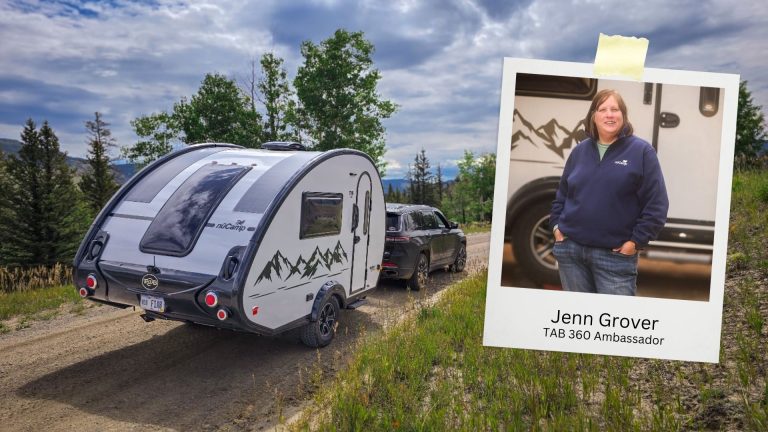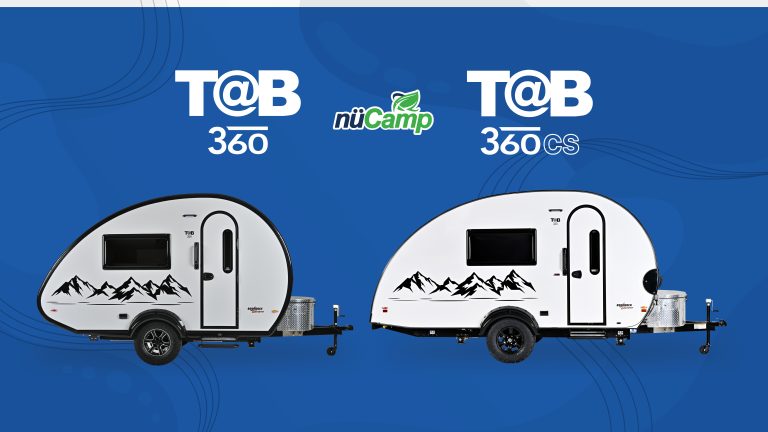Tips for making your camping trip fun for the four-legged!
This is the year you’re going to take that road trip. But the thought of leaving behind Fluffy or Fido is more than you can bear. (Oh, those sad eyes! Oh, those pet-sitter or boarding fees!)
Well, with a teardrop camper, your worries are over. You can take your four-legged friends along for the ride, like more than 65% of RVers including Indiana natives Patrick and Patty McCormick decided to do back in 2005.
The couple bought their first camper because, explained Patrick, “We wanted to take our dog Maddie with us on trips, but it was difficult to find hotels back then that were decent and allowed pets.”
The experience was so successful that the couple continued to travel with their pets, and even started a YouTube channel, Travels with Delaney (named after their cocker spaniel), to share their travels.
“Delaney traveled with us until she passed away at 12,” said Patty. “Now we have a new traveling companion, our Cavalier King Charles spaniel puppy Truman, but we’re keeping the channel name in Delaney’s honor as she will always travel with us in our hearts.”
If you want to take your pet along like the McCormicks do, here are some tips to make the journey fun and safe for everyone.
Introduce your pet to the teardrop.
Before you head out with your pet, give it a chance to get accustomed to its new home. “After we adopted Truman, we took him out for a few times to be in the camper while it was in the driveway to just let him get used to it,” said Patrick.
Spending some quality time with your pet in the camper before you head out will also give you a chance to address potential problems before it’s too late.
Do a road-trip test.
If your pet hasn’t gone on anything more than a quick trip to the vet, you will want to get a few longer runs under its collar to shake out any issues. Some pets get noisy when confined too long to their carrier or in a harness, while others might suffer from motion sickness. Do some practice drives and then check with your vet about any problems that develop.
Make your teardrop pet-friendly.
If your pet will have the run of the camper when it’s parked (note: NEVER leave the pet in the camper when it’s moving!), give it a once-over from the pet’s point of view. Cats are notoriously curious so you want to make sure that anything they can get into is put safely away. Dogs will usually eat anything that’s accessible, so secure food items, cleaning supplies and any meds (pet or human) in the camper cabinets.
Pack pet information and supplies.
Take important information about your pet: medical and vaccination records, prescriptions and instructions for medications, copies of pet insurance cards and policies, and copies with details about any ID tags, tattoos, microchips and licenses.
Research ahead of time to find the nearest vet at your stopping points—just in case. Download the free American Red Cross Pet First Aid App and gather the items on the ASPCA DIY Pet First-Aid Kit list so you’re ready for emergencies. The American Veterinary Medical Association suggests asking your veterinarian about flea, tick and heartworm prevention as well as disease risks associated with camping outdoors.
Make sure your pet has identification on it at all times, and include information such as your cell number and camping address, in case the pet gets loose. It won’t do any good to have the finder call your home since you’re on the road!
Pack food and water (some pets don’t take well to “strange” H20!) as well as clean-up supplies like a pooper-scooper and bags. (Disposable litter pans are a great option for a cat.)
Do some research.
Review the rules and regulations regarding pets at the campsite. Is a pet area or dog park available? Can you set up an exercise pen next to your camper?
Always keep your pet (even a cat) restrained with a harness or leash or in a carrier when moving it from the car into the camper and back again. Walking the dog? Use a controlled leash to keep it close to you and bring along your clean-up items.
One more tip.
If you are planning to leave your pet alone in the camper for short periods of time while you take in the sights or shop for souvenirs, close all the blinds and turn on the fan and air conditioning, recommended Patrick. Don’t count on open windows to keep the camper cool. Even when they are open, the camper can quickly heat up to dangerous temperatures—when it’s 72 degrees outside, the interior can reach 116 degrees within an hour.
A remote temperature sensor with a backup battery can give you some peace of mind if you’re leaving your pet alone in the camper and are worried about possible power failure. The McCormicks take the extra step of letting the campground office know they’ve left a pet in the camper with the A/C on. “We also give them our cell phone number so that they can contact us if there is a power failure or they get complaints about barking,” added Patty.
But remember: the whole point was a road trip with Fido or Fluffy so don’t leave them for too long!
Recent Articles





